 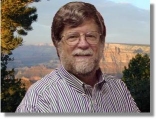 Chaz Cone
Ham Radio and me in High School
1954Me and Ralph Kramden (NOT!)I'm fifteen and the vice-president of the Greater Little Rock Amateur Radio Club. It's unusual for a child to be VP of an organization of mostly adults but nobody else wanted the job.Our club was a public service club as are just about all Ham Radio clubs. We have license to use the radio waves whenever we wish in return for making our services available to the public in case of emergency. In Arkansas, the most common emergency was tornadoes:

 Early Saturday morning I was part of the group that went out into the country to the barn to pick up the bus. Fortunately there was one member of the club who was a truck driver by trade and knew how to operate a manual-transmission, cab-over bus. On the way we stopped for five gallons of diesel fuel; after all, the bus had been sitting in that barn for a decade and no one knew how much fuel it had in it when parked there or the condition of that fuel. The driver drained the fuel tank (it was mostly fumes) and added our five gallons of fresh fuel. It started up and ran just fine. We drove it over to the house of the young ham (my age) whose Dad had agreed to let us clean it up in their driveway. Our bus was full of cobwebs, dust and the radios hadn't been fired up in a long time. We spent all afternoon washing, dusting, cleaning and testing the radios. They were rigged to run off a built-in generator that ran off the bus fuel tank. At about 5pm we were pretty much done and the homeowner asked that we get thing out of his driveway. We looked around and discovered that the driver had left several hours earlier -- leaving just us six teenagers. Well, I had a learner's permit (I'm fifteen, remember) and I had watched the now-absent driver carefully so I figured, "What the heck? I can drive the bus back to the barn". So I got behind the (very large, mostly horizontal) wheel:
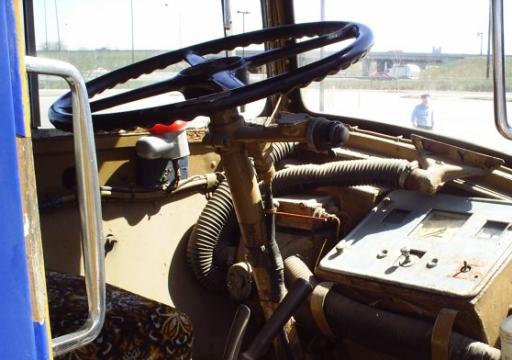
I drove up a short hill to the first cross street and turned left. It was a short block to the next street which headed the direction I needed to go. At the stop sign at the end of the street, just before my left turn, the engine died. It resisted all my attempts to restart it. The starter cranked but no-go. The left turn I needed to make was a bit downhill so I eased off the brake and coasted through the turn. My plan was to roll down the hill and "pop the clutch" to restart the engine as I'd seen my Dad do this before (but not in a bus). We're building up a pretty good head of steam. I divided my attention between steering, looking out the windshield, flipping miscellaneous switches on the dashboard and popping the clutch. It was HOT in the bus (did I mention it was August?) so I operated the lever that opened the front and rear doors. You know the kind; the doors open like an accordian from the center and fold back, sticking outside of the bus about six inches or so. Oh! Now we need to insert a tutorial in the hydraulic systems of a circa-1950 city bus. Pay close attention:
So, the reason the bus wouldn't start was that it was out of fuel. But I didn't know that then. Soooo.. I'm engaged in a fruitless engine-restart exercise while rolling ever faster down what is now a very steep hill. We're going about 40MPH with the doors folded open.. ..and then I hear:
 I looked at the door and there was just the opening; the doors themselves were not in evidence. About then, one of my on-board friends said, "Hey! You hit a car!" If I did, it didn't slow the bus down at all but it DID rip the doors right off the bus. I look back to the right and I see a brand new 1955 Buick:
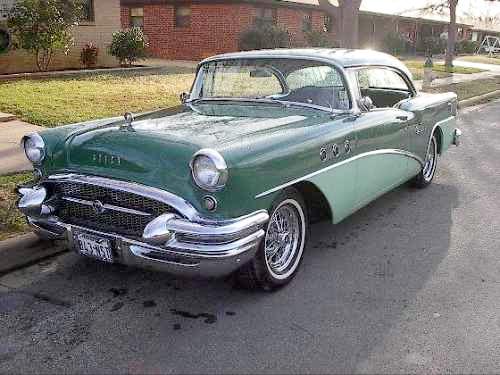 Note: This is the "before" photo...
What would you do? That's right, I hit the brakes.
Until we reached the bottom of the hill and then (ZOOM!) momentum took us up the next hill. We went about half-way up the hill and then, mercifully, we ran out of momentum and the bus stopped. Well, "stopped" is an overstatement. It must have stopped since it changed direction and now began rolling backwards back down the hill to the bottom -- and then continued (backwards) up the hill toward the stripped Buick. I'm actually getting pretty good at steering forwards and backwards by this point.
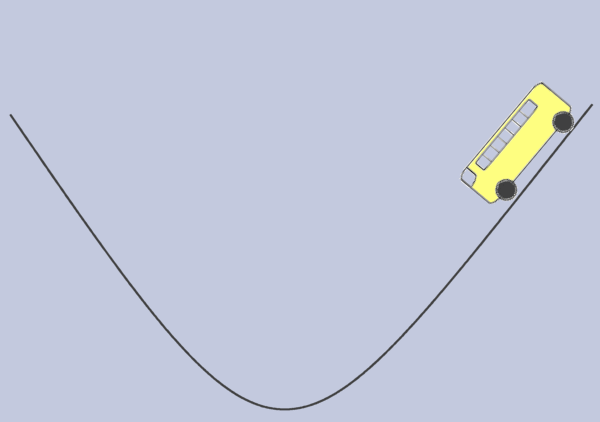
We kept this up for a few more (steadily decaying) cycles until the bus came to a rest at the bottom of the two hills. By now, a crowd had gathered led by the chap who owned the Buick. Turns out he'd just picked it up from the dealer the day before (it still had the paper tag). He was not happy. And the rest of the crowd wasn't all that happy either. I had a few moments to ask my bus-riding compatriots why they didn't do a better spotting job since THAT'S ALL THEY HAD TO DO!!!!!!! but I didn't get much in the way of satisfactory answers. Across the street was the home of a friend from high school. I ran over and rang the bell and was admitted to use their phone to call my Dad. No one answered at home. Since my parents only had one set of friends, I called the friends' home and there they were. I asked their friend David to put Dad on the phone and he did.
Me: "Hello?" Dad: (sighing)"Where are you?"
Things were eventually sorted out. My Dad let me believe that our insurance wouldn't cover all the replacement cost for the Buick and that my hard-earned $189.50 that I had for my new transmitter would have to go into the pot. He let me believe that for a month until finally relenting. Turns out the insurance covered the Buick. When the radio club approached Dad to pay for the damage to the bus, I cannot tell you the words he used as he refused. I COULD tell you -- but I don't use that kind of language (in writing..) For some reason, I wasn't permitted to continue as Vice President of the Greater Little Rock Amateur Radio Club. I don't know why. I sent my (thankfully recovered) $189.50 off to Heathkit and shortly thereafter a big heavy box of parts arrived. I liked Heathkits but I wasn't very good at building them. My goal was always to FINISH the thing; I didn't get much joy out of the building exercise and, regrettably I rushed the soldering. So it's not surprising that usually nothing much worked on the first try. I'd built several less daunting Heathkits over the years and most did not work at once when I finished them. I'd have to go over the wiring several times finding mistakes, cold solder joints, and so forth. So I was pretty surprised when I finished the DX-100, plugged it in and flipped on the power for the "smoke test". It seemed OK! I went throught the designated tests and, except for a couple of little things, the darned thing worked! I was pretty pleased with myself. I did learn an important lesson worth imparting however. During the first power-up test, I discovered I'd dropped a screw onto the chassis between the power transformer and two electrolytic filter capacitors. These capacitors were about 4" high and an inch in diameter and were covered by cardboard sleeves. I couldn't get my fingers down between the capacitors and the transformer housing to pick up the screw; the space was just too tight. So I slipped the cardboard sleeves off the capacitors in order to make a little bit more room:
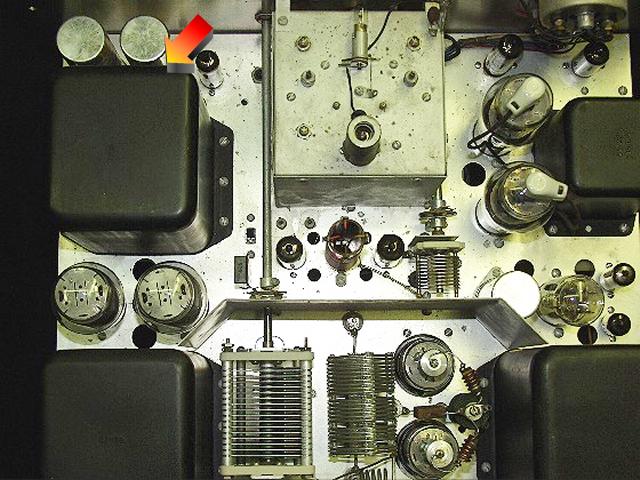

Anyway, I was eventually on the air with my new SX-99 receiver and my new DX-100 transmitter. 1956I was already deeply into Ham Radio by the time I got to high school. You think that the word "geek" was invented just for computer nerds? No way. Ham Radio was just about the geekiest activity you could find in high school. And the rest of the students knew it.There were a handful of other hams in the school so we decided to petition the school to establish/permit an Amateur Radio Club. Goodness knows, there were high school clubs galore -- and we were only asking for a place to put a station, permission to put antennae on the roof and to pass feedlines between them. No biggie. Everywhere it seems, the rules for high school clubs require a faculty advisor. This makes sense with all these little anarchists running around. The day they had the meeting to assign advisors for this particular class year, an insufficient number of faculty volunteers attended the meeting. So, rather than a science teacher (which you'd expect), an English Literature teacher named Miss Mary Piercy was chosen in absentia to mentor the nascent Little Rock Central High School Amateur Radio Club:
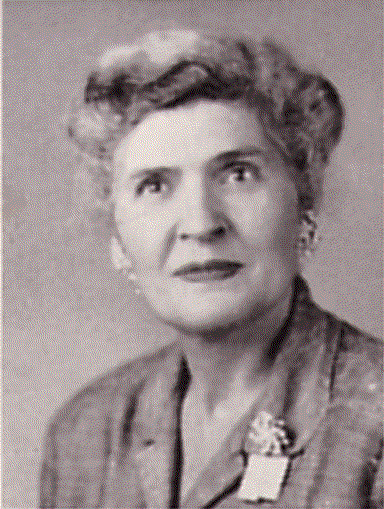

In due course we received the appropriate permissions and, with the help of the school custodian, were able to get some rudimentary wire antennas on the roof (five stories above the ground). They gave us an abandoned boys restroom on the fourth floor to use as our hamshack. It was about 8' wide and 12' deep. And we had to dodge the remains of various plumbing fixtures (you get the idea). There was an outside window and we were able to bring the antenna feedlines in that way. All in all, quite satisfactory:
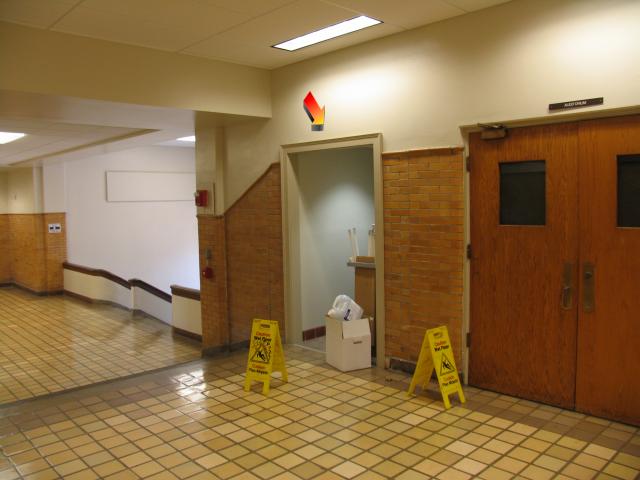 On a recent visit I went to photograph the room to find it was being turned into an elevator. But here's where it was.
Each morning before school our little gaggle of geeks would gather and get on the air from our hamshack and, often, in the afternoons after school as well. Several of our members didn't have a home station so this was their only way to exercise their hobby. It didn't take long for the non-ham bullies in the school to decide to make our lives as unpleasant as possible. Down the hall from our converted restroom was a 10th grade homeroom:
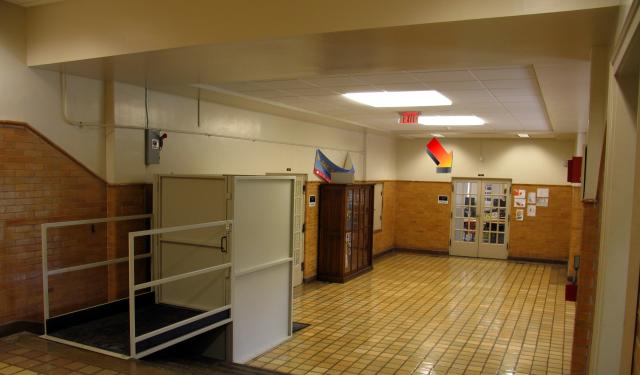
Then, one of our members suggested that we make it less joyful for our antagonists. The hamshack/restroom door was a heavy wooden one with a frosted glass panel stencilled "BOYS". It had a pull handle and a glass transom above it. There was no way to lock it (it was once a restroom, of course). Hmmmm.... We brought in a spark coil from a Model T Ford:
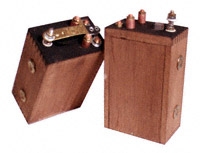

When our lookout saw the boys across the hall approaching our door, he signaled and we closed the switch. Time out for a bit of education for those unaware of what comes next:
  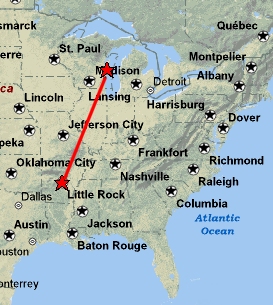
I received a summons to the Vice-Principal's office; I had no idea what I'd done now. But he welcomed me warmly and asked if I would bring in my ham rig from home, set it up in his office and provide the Little Rock-end of a communications link to Manitowoc. I jumped at the chance and, for weeks I'd get out of a class to go handle our end of that link. It didn't work every day (the vagaries of propagation on the 40 meter band) but it mostly did. And, I got my picture in the paper:
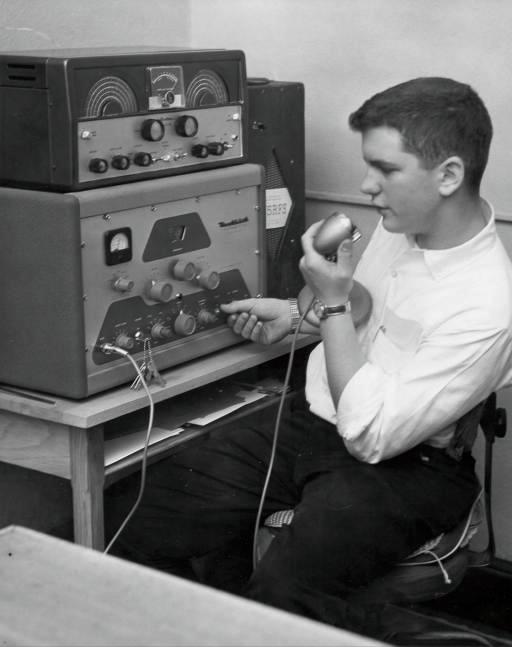 Omigawd!! Is that a pocket protector?!?!?
A non-Ham Radio aside:I graduated in June of 1957; three months later everyone in the world knew about Little Rock Central High School. School integration came to America that fall and Little Rock was one of the most visible test cases. The Arkansas National Guard, Governor Orval Faubus, the "Little Rock Nine", Justice Department and all. Though I wasn't there, I left behind a girlfriend who was a senior that year. She said (newspaper accounts notwithstanding) that the only real problem was this:
|